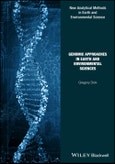The first comprehensive synthesis of genomic techniques in earth sciences
The past 15 years have witnessed an explosion of DNA sequencing technologies that provide unprecedented insights into biology. Although this technological revolution has been driven by the biomedical sciences, it also offers extraordinary opportunities in the earth and environmental sciences. In particular, the application of "omics" methods (genomics, transcriptomics, proteomics) directly to environmental samples offers exciting new vistas of complex microbial communities and their roles in environmental and geochemical processes. This unique book fills the gap where there exists a lack of resources and infrastructure to educate and train geoscientists about the opportunities, approaches, and analytical methods available in the application of omic technologies to problems in the geosciences.
Genomic Approaches in Earth and Environmental Sciences begins by covering the role of microorganisms in earth and environmental processes. It then goes on to discuss how omics approaches provide new windows into geobiological processes. It delves into the DNA sequencing revolution and the impact that genomics has made on the geosciences. The book then discusses the methods used in the field, beginning with an overview of current technologies. After that it offers in–depth coverage of single cell genomics, metagenomics, metatranscriptomics, metaproteomics, and functional approaches, before finishing up with an outlook on the future of the field.
- The very first synthesis of an important new family of techniques
- Shows strengths and limitations (both practical and theoretical) of the techniques
- Deals with both theoretical and laboratory basics
- Shows use of techniques in a variety of applications, including various aspects of environmental science, geobiology, and evolution
Genomic Approaches in Earth and Environmental Sciences is a welcome addition to the library of all earth and environmental scientists and students working within a wide range of subdisciplines.
Table of Contents
Preface ix
Acknowledgments x
Abbreviations xi
1 Introduction 1
1.1 Exploring the Microbial World 1
1.2 The DNA Sequencing Revolution: Historical Perspectives 4
References 7
2 The Architecture of Microbial Genomes 11
Introduction 11
2.1 Genome Size, Organization, and Replication 11
2.2 Nucleotide Composition 14
2.3 Ecological and Evolutionary Aspects of Microbial Genomes 16
2.3.1 The Role of Viruses in Promoting Genomic Diversity 18
2.4 Genomic Diversity in Microbial Communities 19
2.5 Does Genomic Diversity Matter? 21
References 21
3 Application of Omics Approaches to Earth and Environmental Sciences: Opportunities and Challenges 27
Introduction 27
3.1 New Perspectives on Microbial Biogeochemistry 27
3.1.1 Redefining the Carbon and Nitrogen Cycles 27
3.1.2 Omics as Sensitive and Efficient Tracers of Biogeochemical Processes 29
3.1.3 Omics Data is Valuable for Biogeochemical Models 29
3.1.4 Understanding Biotic Responses and Feedbacks to Global Change 29
3.2 A Genomic Record of Biological and Geochemical Evolution 30
3.3 Challenges and Limitations of Omics Approaches 32
3.4 Omics as a Complement to Other Approaches 33
References 34
4 Overview of Approaches: From Whole–Community Shotgun Sequencing to Single–Cell Genomics 41
Introduction 41
4.1 Choosing the Right Approach 41
4.1.1 Whole–Community Approaches 41
4.1.2 Targeted Approaches: Physical, Microbiological,and Isotopic Enrichment 43
4.1.3 Single–Cell Genomics 44
4.2 Experimental Design and Sampling Considerations 45
4.2.1 Replication 45
4.2.2 Estimating Sequencing Effort: How Much Sequencing Do I Need to Do? 46
4.2.3 From Sample to Data: Biases Due to Preservation,Storage, Extraction, and Sequencing 47
4.2.4 Estimating Absolute Abundance with Internal Standards 49
4.3 Overview of Current DNA Sequencing Technologies 49
4.4 Quality Control and Sequence Processing 51
4.4.1 Dereplication 51
4.4.2 Trimming 52
References 53
5 Genomics of Single Species and Single Cells 59
Introduction 59
5.1 Algorithms for Genome Assembly 60
5.2 Challenges of Genome Assembly 61
5.3 Scaffolding 63
5.4 Programs and Pipelines for Genome Assembly 63
5.5 Evaluation of Genome Assemblies 66
5.6 Single–Cell Genomics 67
References 69
6 Metagenomics: Assembly and Database–Dependent Approaches 73
Introduction 73
6.1 To Assemble or Not To Assemble? 73
6.2 Database–Dependent Approaches 75
6.3 Database–Independent Approaches: De Novo Assembly 78
6.4 Evaluation of Metagenomic Assemblies 82
6.5 A Philosophy of Metagenome Assemblies 82
References 83
7 Metagenomic Binning 89
Introduction 89
7.1 Genomic Signatures of Nucleotide Composition 90
7.2 Binning Programs 91
7.3 Additional Signal and Steps for Binning: Coverage,
Taxonomic Data, and Mini ]Assemblies 93
7.4 Identifying, Evaluating, and Assessing the Completeness of Genomic Bins 95
References 97
8 Annotation: Gene Calling, Taxonomy, and Function 101
Introduction 101
8.1 Gene Calling 102
8.2 Determining Taxonomic Composition 103
8.3 Functional Annotation 106
8.3.1 Overall Approach to Functional Annotation 106
8.3.2 Predicting Metabolic Pathways 107
8.3.3 The Importance of Experimental Annotation 108
References 109
9 Metatranscriptomics 113
Introduction 113
9.1 Sample Collection 114
9.2 RNA Extraction and Preparation of cDNA Libraries 115
9.2.1 Should rRNAs Be Removed Prior to Library Preparation and Sequencing? 115
9.3 Assigning Transcripts to Genes or Other Features 115
9.4 De Novo Assembly 116
9.5 Absolute Versus Relative Abundance and Normalization 118
9.6 Detecting Differential Expression 122
References 123
10 Metaproteomics 127
Introduction 127
10.1 Methodologies for Basic Proteomics 128
10.2 The Importance of Genomic Databases for Interpreting Proteomics Data 130
10.3 Quantitative Proteomics 131
10.4 Combining Stable Isotope Probing with Proteomics to Track Microbial Metabolism 133
References 133
11 Lipidomics and Metabolomics 137
Introduction 137
11.1 Lipidomics 137
11.2 Metabolomics 139
References 140
12 Downstream and Integrative Approaches and Future Outlook 145
Introduction 145
12.1 Comparative Omics 145
12.2 Statistical Approaches 146
12.3 Visualization 147
12.4 Cyberinfrastructure for Environmental Omics 148
12.4.1 Software Platforms for Integrated Analyses and Data Storage 149
12.5 Data and Sample Archival 151
12.6 Modeling 151
12.7 Emerging Trends and Future Outlook 153
References 155
Index 161








